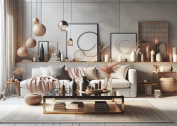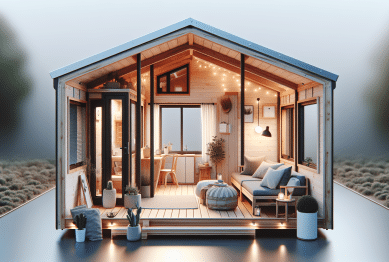Explore the world of minimalism and discover how simplifying daily life can elevate happiness, mental clarity, and well-being. This guide unpacks practical steps for embracing minimalism, the benefits for both home and mind, and what real studies reveal about decluttering your space and routines.
What Is Minimalism and Why Are People Talking About It?
Minimalism goes beyond just neat rooms. It’s a lifestyle approach focused on living with less to make space for what truly matters. People are drawn to minimalist living because it promises clarity, calm, and more time for what brings genuine joy. As daily lives become more cluttered, both physically and mentally, many find that minimalism is a refreshing alternative to consumerism. It’s not about deprivation, but conscious choices. Minimalism lets you reclaim your focus and create a home that feels inspiring, not overwhelming. Interest has surged as studies link clutter to increased stress, fueling curiosity about decluttering strategies that work (Source: https://www.apa.org/news/press/releases/stress/2015/impact).
What surprises most people about minimalism is its versatility. This isn’t a one-size-fits-all trend. Minimalism adapts, whether you live in a sprawling house or a small apartment. Small shifts, like quality over quantity or reducing digital distractions, have big impacts. Designers and wellness experts note that minimalist interiors can boost focus and calm by reducing visual chaos. The popularity of minimalist influencers and Pinterest boards reflects rising public interest, further amplified by enjoyable design aesthetics and the movement’s eco-friendly appeal.
Underlying the minimalist movement is a quest for intentionality. Many choose this path because it asks: what is truly necessary? It helps people reflect on their relationship with possessions, habits, and even commitments. This mental clarity often translates into improved decision-making and a stronger sense of freedom. Stories of those who embrace minimalism typically mention feeling lighter, less rushed, and more satisfied. Minimalism isn’t about empty shelves. It’s a daily practice that helps people find value in simplicity, sparking both emotional and practical benefits.
How Minimalism Can Change Your Living Space
Minimalist home design has shaped everything from furniture trends to architectural layouts. A space crafted with intention feels open and soothing; clutter-free environments support relaxation and positive mood. Research shows that environments with less visual noise can lead to greater productivity and fewer feelings of overwhelm (Source: https://news.harvard.edu/gazette/story/2020/11/minimalism-design-home-and-well-being/). Small changes, like reducing decorative items or choosing multipurpose furniture, clear pathways—both literally and mentally. Even in compact apartments, minimalism can create a sense of expansion and invite more light.
Some find it helpful to start with the most used rooms—like the kitchen or living area. Minimalism here isn’t about stark emptiness; it’s about keeping visible only the things you love or use often. Open shelving, neutral color palettes, and carefully selected art or plants transform a home’s feel. For many, the process of decluttering starts a positive feedback loop. Each unused item removed is replaced by a sense of control and tranquility—an effect supported by neuroscience studies on cognitive load and environment (Source: https://www.psychologytoday.com/us/blog/science-choice/201709/the-psychological-benefits-minimalism).
Transitioning to a minimalist living space doesn’t require a total makeover. Instead, try removing just five items from one room or rethinking how storage is used. Minimalism encourages ongoing, non-judgmental evaluation of what’s essential. Homes that support this mindset feel easier to maintain. For families, it can become a shared value, teaching children to appreciate fewer—yet more meaningful—belongings. Over time, the practice of paring down frequently spills into other facets of life, encouraging simpler routines and lighter emotional loads.
Minimalism’s Impact on Mental Well-Being
There’s growing evidence that less clutter contributes to lower stress and higher life satisfaction. Minimalism is not just design; it’s about reshaping thought patterns around consumption and attachment. According to experts, clearing physical spaces leads to mental clarity (Source: https://www.ncbi.nlm.nih.gov/pmc/articles/PMC7699285/). When there are fewer things competing for attention, focus improves, and anxiety about unfinished tasks diminishes. People often report sleeping better, feeling more at peace, and focusing easier in tidy spaces.
Minimalism encourages mindfulness. The act of evaluating what to keep or let go of demands presence and reflection. This can nurture an ability to savor the present moment, rather than chase after more. For some, minimalism transforms into a wellness tool: fewer possessions mean less cleaning, organizing, and worrying. Minimalist routines also cut down on decision fatigue—a major source of daily mental exhaustion. The freedom to let go of the unnecessary is liberating. For those interested in stress management or meditation, minimalism is a strong companion practice.
Emotional benefits of minimalism can be significant. Studies note a strong link between excessive materialism and diminished happiness. Minimalist lifestyles counteract this by helping individuals focus on gratitude, experiences, and relationships—elements consistently associated with well-being (Source: https://greatergood.berkeley.edu/article/item/three_science_backed_reasons_simpler_better). Many people discover after decluttering that memories are not tied to objects, but to people and moments. Letting go of things often means gaining something more valuable—a sense of calm and connection.
Steps to Begin Your Minimalist Journey
Starting to live with less may feel daunting, but small, steady changes yield lasting results. Experts recommend beginning with a single drawer or shelf. As choices become easier, you’ll likely feel motivated to tackle larger spaces. Breaking the process into bite-sized tasks minimizes overwhelm. Useful tools include checklists or the “one in, one out” rule, where you only bring a new item in if you remove another. Personal reflection is key—ask what purpose each item serves and whether it truly adds value to your day.
Decluttering extends beyond physical possessions. Digital minimalism—like managing notifications, organizing files, or scheduling intentional screen-free time—also supports well-being. Scheduling time to regularly review photos, emails, or online subscriptions can prevent digital chaos. As habits shift, routines become easier and lighter. For those with busy households, it helps to involve everyone. Open communication about what matters most at home supports harmony and shared purpose. Some families find it helpful to set communal goals for space or routines, making it a collaborative and rewarding process.
Staying consistent is often the biggest challenge. Minimalism isn’t a race or contest; setbacks are natural. What matters is returning to intention: why pursue simplicity? Reminders, vision boards, or minimalism communities online offer support and new ideas. Over time, new habits replace old ones. Many find themselves buying less, being more selective, and focusing on experiences over things. Step by step, minimalist living transitions from a project to a way of being—one that makes room for joy, clarity, and meaning.
Embracing Minimalist Entertainment and Leisure
Minimalist living doesn’t mean less fun—it’s often the opposite. By prioritizing experiences, people find richer enjoyment in everyday moments. Simple pleasures like reading outdoors, cooking with loved ones, or practicing yoga in a calm corner replace frantic shopping trips or TV binges. Studies show that people who invest in experiences report greater happiness than those focused on possessions (Source: https://news.stanford.edu/2023/01/12/minimalism-life-satisfaction/). Minimalist leisure isn’t about cost; it’s about quality and intention. Play a board game, stroll through a park, or enjoy music without distractions—these moments bring connection and presence.
Minimalism can transform entertainment habits. Streaming services encourage binge-watching, but setting simple boundaries—like only watching carefully chosen shows—boosts satisfaction and cuts mindless consumption. Practicing digital restraint, such as device-free dinners or unplugged weekends, can redefine leisure and strengthen relationships. Hobbies requiring few tools—sketching, journaling, or gardening—invite creativity and relaxation. Over time, many discover that simpler activities are more memorable and generate positive emotions long after the moment has passed.
For families, minimalist entertainment fosters togetherness. Less cluttered playrooms or activity bins encourage imaginative play. Board games, outdoor activities, and shared rituals become central. When possessions don’t dominate attention, people are more present with each other. This approach cultivates stronger bonds and deeper appreciation for small joys. As entertainment becomes more intentional, it aligns with the minimalist goal: to make space for what matters most.
Finding Balance: Minimalism, Consumer Culture, and You
Living minimally is not about shunning all possessions or trying to reach some elusive standard. Rather, it’s about aligning your environment and choices with your values. Modern consumer culture often pushes for more—more purchases, more gadgets, more obligations. Minimalism asks: what truly serves you? Practicing conscious consumption—asking before buying if an item will enrich your life—builds financial confidence and reduces clutter. This mindful approach to consumerism is linked to reduced stress about money and improved mental health (Source: https://www.consumerfinance.gov/about-us/blog/how-practicing-minimalism-can-help-your-finances/).
Minimalism is also a response to fast fashion and disposable trends. Choosing fewer, higher quality goods reduces waste and supports sustainable habits. Many people report that shifting away from accumulation brings a new appreciation for items that last and memories that matter. The overall effect is freedom—from maintenance, from constant comparison, and from the urge to always “keep up”. Minimalism doesn’t mean missing out; it’s about creating a life that feels intentional and fulfilled.
Above all, minimalism is personal. There’s no perfect formula. Every person’s path will look different. The central idea remains: prioritize the few things that amplify happiness, health, and connection. Letting go makes space for joy, whether that’s a light-filled room, an uncluttered mind, or a schedule full of what excites you. Practicing minimalism is ongoing—each step is a step toward a life that feels truly yours.
References
1. American Psychological Association. (2015). Stress in America: The Impact of Stress. Retrieved from https://www.apa.org/news/press/releases/stress/2015/impact
2. Harvard Gazette. (n.d.). Minimalism in Design and Home Life. Retrieved from https://news.harvard.edu/gazette/story/2020/11/minimalism-design-home-and-well-being/
3. Psychology Today. (2017). The Psychological Benefits of Minimalism. Retrieved from https://www.psychologytoday.com/us/blog/science-choice/201709/the-psychological-benefits-minimalism
4. National Center for Biotechnology Information. (2020). Cognitive load and the power of simplicity. Retrieved from https://www.ncbi.nlm.nih.gov/pmc/articles/PMC7699285/
5. Greater Good Science Center. (n.d.). Three Science-Backed Reasons Why Simpler Is Better. Retrieved from https://greatergood.berkeley.edu/article/item/three_science_backed_reasons_simpler_better
6. Stanford News. (n.d.). Minimalism increases life satisfaction. Retrieved from https://news.stanford.edu/2023/01/12/minimalism-life-satisfaction/









